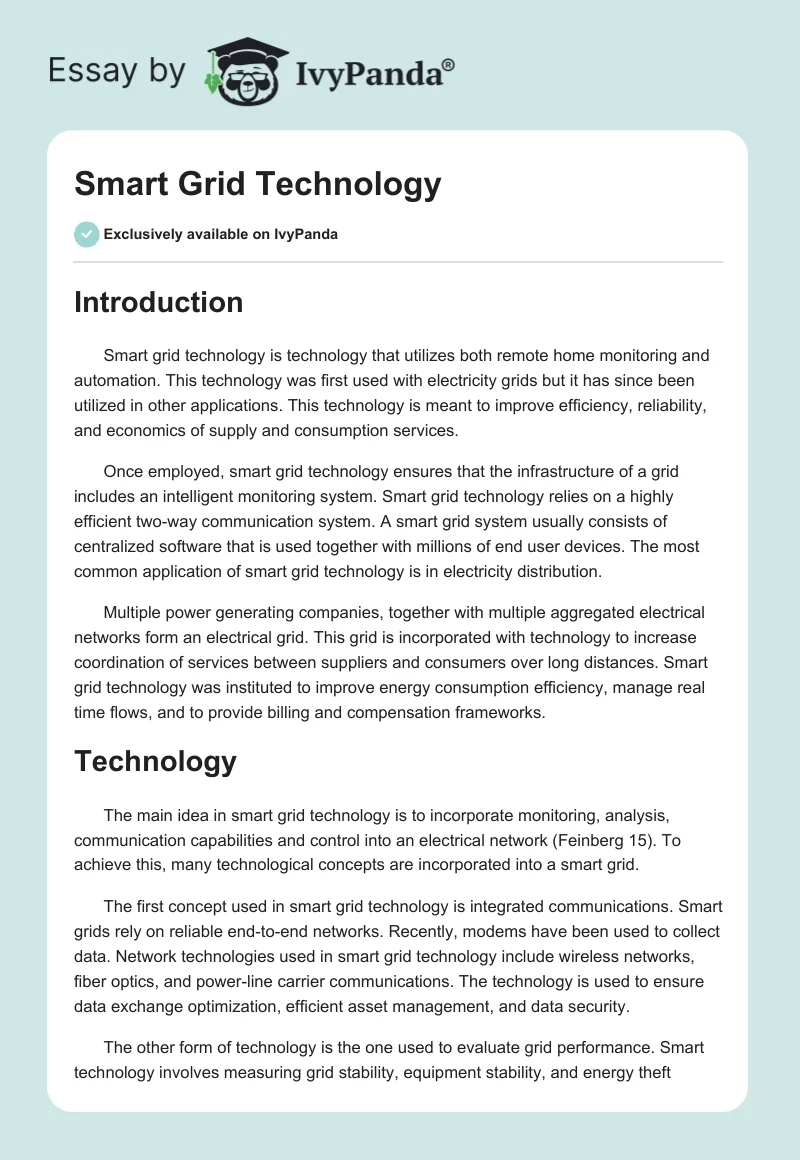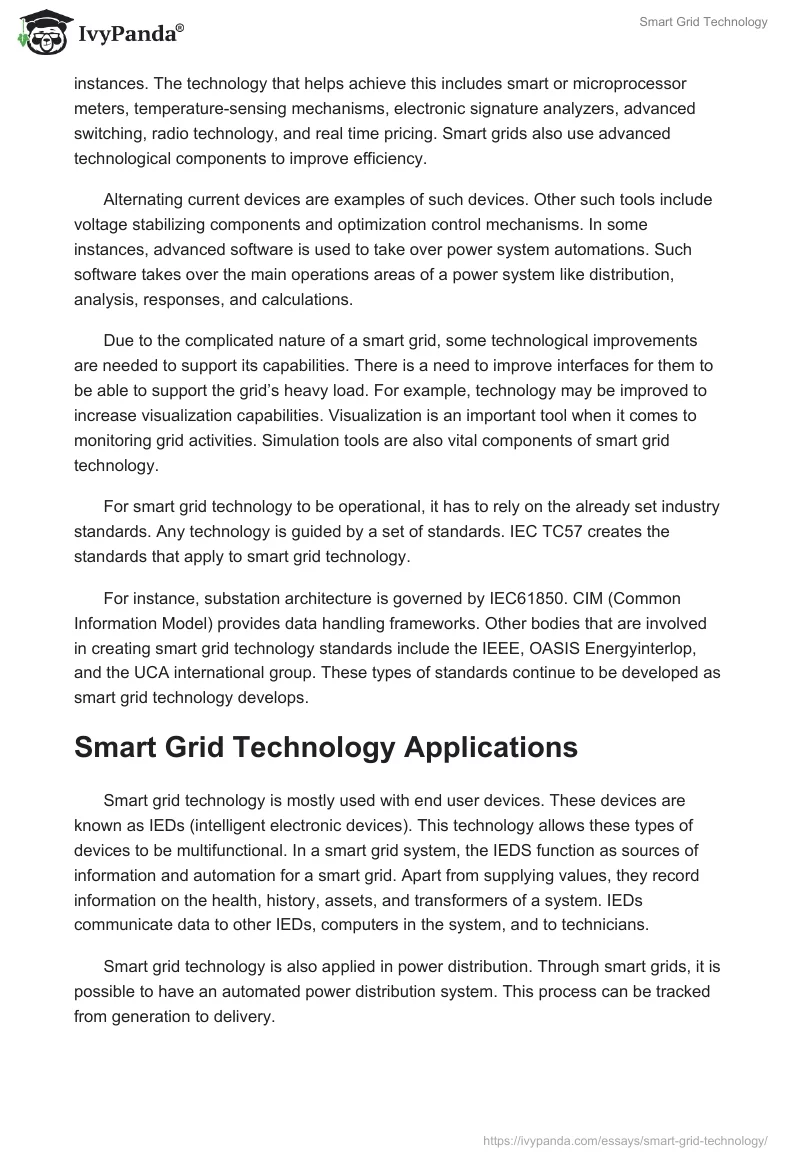Introduction
Smart grid technology is technology that utilizes both remote home monitoring and automation. This technology was first used with electricity grids but it has since been utilized in other applications. This technology is meant to improve efficiency, reliability, and economics of supply and consumption services.
Once employed, smart grid technology ensures that the infrastructure of a grid includes an intelligent monitoring system. Smart grid technology relies on a highly efficient two-way communication system. A smart grid system usually consists of centralized software that is used together with millions of end user devices. The most common application of smart grid technology is in electricity distribution.
Multiple power generating companies, together with multiple aggregated electrical networks form an electrical grid. This grid is incorporated with technology to increase coordination of services between suppliers and consumers over long distances. Smart grid technology was instituted to improve energy consumption efficiency, manage real time flows, and to provide billing and compensation frameworks.
Technology
The main idea in smart grid technology is to incorporate monitoring, analysis, communication capabilities and control into an electrical network (Feinberg 15). To achieve this, many technological concepts are incorporated into a smart grid.
The first concept used in smart grid technology is integrated communications. Smart grids rely on reliable end-to-end networks. Recently, modems have been used to collect data. Network technologies used in smart grid technology include wireless networks, fiber optics, and power-line carrier communications. The technology is used to ensure data exchange optimization, efficient asset management, and data security.
The other form of technology is the one used to evaluate grid performance. Smart technology involves measuring grid stability, equipment stability, and energy theft instances. The technology that helps achieve this includes smart or microprocessor meters, temperature-sensing mechanisms, electronic signature analyzers, advanced switching, radio technology, and real time pricing. Smart grids also use advanced technological components to improve efficiency.
Alternating current devices are examples of such devices. Other such tools include voltage stabilizing components and optimization control mechanisms. In some instances, advanced software is used to take over power system automations. Such software takes over the main operations areas of a power system like distribution, analysis, responses, and calculations.
Due to the complicated nature of a smart grid, some technological improvements are needed to support its capabilities. There is a need to improve interfaces for them to be able to support the grid’s heavy load. For example, technology may be improved to increase visualization capabilities. Visualization is an important tool when it comes to monitoring grid activities. Simulation tools are also vital components of smart grid technology.
For smart grid technology to be operational, it has to rely on the already set industry standards. Any technology is guided by a set of standards. IEC TC57 creates the standards that apply to smart grid technology.
For instance, substation architecture is governed by IEC61850. CIM (Common Information Model) provides data handling frameworks. Other bodies that are involved in creating smart grid technology standards include the IEEE, OASIS Energyinterlop, and the UCA international group. These types of standards continue to be developed as smart grid technology develops.
Smart Grid Technology Applications
Smart grid technology is mostly used with end user devices. These devices are known as IEDs (intelligent electronic devices). This technology allows these types of devices to be multifunctional. In a smart grid system, the IEDS function as sources of information and automation for a smart grid. Apart from supplying values, they record information on the health, history, assets, and transformers of a system. IEDs communicate data to other IEDs, computers in the system, and to technicians.
Smart grid technology is also applied in power distribution. Through smart grids, it is possible to have an automated power distribution system. This process can be tracked from generation to delivery.
One application of automated distribution and transmission is in fault identification in case of a power failure. Another application is in maintaining devices and optimizing assets. Automation also helps in data acquisition and when supervising operations. Automation also ensures better monitoring of load flow, load balancing, and generation control.
Smart grid technology centralizes the decision-making system in an organization. Most smart grid systems are organized in hierarchies. This mode ensures that data is collected and organized in different levels. In turn, this ensures that the decision making process is aligned. This is because if a problem occurs in the lower level, it can be sorted out without involving the top management. This eases the management’s work and ensures efficiency.
Smart grid technology can be applied when pricing electricity products. This is very important especially in situations where pricing incorporates other variables (Federal Energy Regulatory Commission 4). For example, some power companies reduce prices during off-peak periods to encourage usage during these times. To make this happen, smart grid technology uses intelligent metering services. These can track usage during different times with different prices.
Conclusion
In conclusion, smart grid technology has changed the way power is generated and transmitted. Most developed countries have been using this technology for quite some time. This technology has achieved great efficiency in power distribution management. A lot still needs to be done to make smart grid technology easy to adopt.
Works Cited
Federal Energy Regulatory Commission 2008, Assessment of Demand Response and Advanced Metering. Web.
Feinberg, Richard 2009, Achieving Consumer Acceptance of the Smart Grid -The Intelligent Project. Web.


